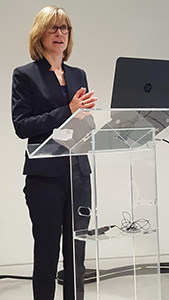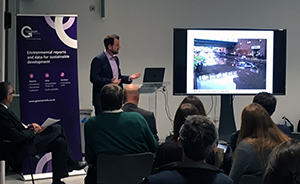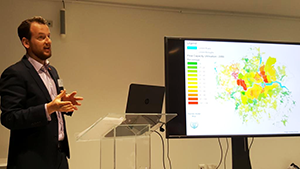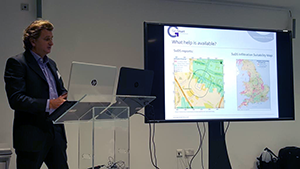Understanding and working better with authorities on SuDS planning conditions
 It was standing room only at the Urban Innovation Centre in Clerkenwell, London for our latest seminar on Sustainable Drainage Systems (SuDS). Architects, lawyers, engineers and consultants came together to understand more about the SuDS regime, good SuDS design and local authority planning conditions. We round up the key points from the sessions.
It was standing room only at the Urban Innovation Centre in Clerkenwell, London for our latest seminar on Sustainable Drainage Systems (SuDS). Architects, lawyers, engineers and consultants came together to understand more about the SuDS regime, good SuDS design and local authority planning conditions. We round up the key points from the sessions.
Our first speaker was Sue Illman, Managing Director of Illman Young, a highly respected landscape architect, past president of the Landscape Institute and a key contributor to the CIRIA SuDS Manual.
Sue said that one of the biggest misconceptions of SuDS is that they have to take up large tracts of land and therefore challenge the economic viability for developers.
However, the sheer variety of SuDS options available mean that flood risk can be mitigated successfully often through a combination of rain gardens, naturally planted roofs and planted features that require little maintenance.
Sue challenged architects and their clients to view water as an asset and not a problem for housing schemes and for mitigating flood risk. Many areas of the UK suffer water stress and so projects should prioritise effective conservation and reuse of available rainfall.
Getting good SuDS design
 Good SuDS design should consider the size of the plot, available space within the plot in terms of appropriate SuDS features – and designed so they work together to slow the flow of surface water runoff, which could otherwise overload sewers or water courses.
Good SuDS design should consider the size of the plot, available space within the plot in terms of appropriate SuDS features – and designed so they work together to slow the flow of surface water runoff, which could otherwise overload sewers or water courses.
A key point from Sue was that SuDS should not be retrofitted into an already planned site to satisfy planning or BREEAM conditions. This can lead to inefficient design and ultimately more cost.
She concluded that home buyers are more flood aware and want to know if developments are resilient. By encouraging more Water Sensitive Urban Design and demonstrating sustainable flood risk management measures as part of the benefits of the site, homebuyers will appreciate the value, which can form a significant selling point for developers.
Meeting SuDS planning conditions
 Up next was Heidi Copland, Planning Partner at DMH Stallard, who reviewed the current legislative and guidance regime for SuDS. There have been a number of false starts with SuDS, but drainage guidance is clear and the regime is tightening.
Up next was Heidi Copland, Planning Partner at DMH Stallard, who reviewed the current legislative and guidance regime for SuDS. There have been a number of false starts with SuDS, but drainage guidance is clear and the regime is tightening.
A drainage hierarchy exists in both the Building Regulations and National Planning Policy Framework (NPPF) which prioritises drainage through soil infiltration rather than to a sewer. All developments in a flood risk area and all major developments (10 or more dwellings) need to demonstrate that the project will not increase flooding elsewhere or downstream.
The latest EFRA committee report has recommended that the full provisions of Section 3 of the Water Management Act 2010 now be implemented, including full consultation with water companies on SuDS and responsibility for adoption and ongoing management by local authorities.
SuDS is treated as a planning issue rather than under environmental legislation or protection. The central issue is whether SuDS are considered “appropriate” for a site.
Developers may consider there is a land take issue, or space constraints do not allow them – but these are largely irrelevant. Ultimately, it will be down to the professional planning judgement of the relevant local authority and the conditions that are set out in response to development applications.
These conditions will determine the viability of site in terms of construction and maintenance of specific SuDS to meet required surface water runoff calculations. Therefore, it is important that costs are clearly mapped and understood by clients.
Heidi concluded by referring delegates to:
Local authority planning teams: “We want to help and not be a barrier”
 Our next eagerly anticipated speaker was George Warren, Flood Risk Manager at London Borough of Hammersmith and Fulham. He emphasized that the requirements of NPPF mean that local authorities must scrutinise development for flood risk and liaise with Lead Local Flood Authorities (LLFAs), to ensure that surface water runoff calculations meet the authorities’ guidance.
Our next eagerly anticipated speaker was George Warren, Flood Risk Manager at London Borough of Hammersmith and Fulham. He emphasized that the requirements of NPPF mean that local authorities must scrutinise development for flood risk and liaise with Lead Local Flood Authorities (LLFAs), to ensure that surface water runoff calculations meet the authorities’ guidance.
Increasingly, LLFAs and local authorities are more robust in their approach – albeit that the guidance varies frequently between authorities.
George demonstrated that in London, for example, the need for SuDS is huge. The capital faces major sewer capacity issues and the Boroughs are now co-ordinating policy under an overarching flood plan with the Greater London Authority. Key locations now face severe inundation from 1 in 2 year surface water storms. Boroughs are now implementing a requirement for a variety of SuDS measures to slow the flow of water into sewers unable to cope.
 Most London authorities are seeking equivalent greenfield drainage standards and minimum 50% reduction in surface water flow through SuDS features. London is not alone with this issue and it is a requirement now being repeated across many authorities in England (Wales and Scotland have devolved arrangements that are more stringent still).
Most London authorities are seeking equivalent greenfield drainage standards and minimum 50% reduction in surface water flow through SuDS features. London is not alone with this issue and it is a requirement now being repeated across many authorities in England (Wales and Scotland have devolved arrangements that are more stringent still).
George reassured delegates that authority planning teams and LLFAs do not want to be seen as a barrier to planning approval. They want to help and it benefits everyone if they are consulted early with the right data on site suitability so the best solution can be agreed.
The right site data for the right approach
 Chris Taylor, our Product Development Director, concluded the seminar by showing how SuDSmart Reports from GeoSmart can help. We are assisting architects and their clients to understand site drainage conditions, demonstrate whether surface water infiltration or other SuDS measures would be effective, or whether discharge to a water course or sewer is the right response.
Chris Taylor, our Product Development Director, concluded the seminar by showing how SuDSmart Reports from GeoSmart can help. We are assisting architects and their clients to understand site drainage conditions, demonstrate whether surface water infiltration or other SuDS measures would be effective, or whether discharge to a water course or sewer is the right response.
Our more detailed SuDSmart Plus and Pro reports prepare runoff calculations and outline SuDS scheme designs. This enables a more joined up discussion with planning authorities to support pre-planning stages and get better buy in.
It is also important to ensure that the land quality of brownfield sites with potential contamination are examined, otherwise a SuDS design could create a pollution pathway and serious cost risks. We can provide a combined SuDSmart and EnviroSmart Phase 1 risk assessment report package for this purpose.
For more information on our SuDSmart and EnviroSmart Reports, to discuss a condition or a site with us call 01743 298 100 or email enquiries@geosmartinfo.co.uk.

 It was standing room only at the Urban Innovation Centre in
It was standing room only at the Urban Innovation Centre in 

